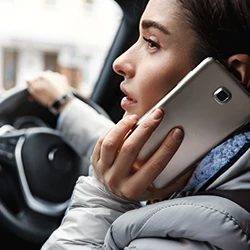California has some of the strictest cell phone usage laws in the nation, and this extends to Los Angeles as well.
Recent changes in the LA hands-free phone driving law have garnered attention from both drivers and authorities. As technology's role in our lives evolves, so do the enforcement and interpretation of these regulations.
As a legal attorney with years of experience handling car accident cases, this article will discuss the latest updates regarding LA's hands-free phone driving law.
I will also provide essential information on how understanding these laws can help strengthen your case.
Quick Summary
- California's hands-free phone driving law prohibits using handheld cell phones while driving.
- Increased enforcement measures are implemented to reduce distracted driving crashes and encourage driver compliance.
- Injury victims should seek legal advice for compensation for damages caused by a distracted driver.
What Is the Latest LA Hands-Free Phone Driving Law?
The latest LA hands-free phone driving law is now forbidding the use of handheld cell phones while driving unless the device is dashboard-mounted or in voice activation mode [1].
This change was due to the alarming statistics from the California Office of Traffic Safety, which revealed that 74.2% of all vehicle collisions in the state are due to driver negligence related to cell phone use, with talking or texting on a cell phone being the most prevalent form of distraction [2].
Strengthened Enforcement Measures
LA's revised hands-free phone driving law brings more robust enforcement measures for driver compliance.
Here are the key points:
- All drivers are restricted from calling and texting using handheld cell phones.
- The only exception is when the phone is being used in a voice-operated, hands-free mode by a driver over the age of 18.
- Holding a cell phone while driving is strictly prohibited.
- Police officers can issue citations to distracted drivers.
Impact on Road Safety

Studies have shown that texting bans can reduce hospitalizations by 7%.
By prohibiting handheld devices while driving and encouraging the use of hands-free devices, the law aims to decrease distractions and enhance overall road safety.
In addition to the hands-free law, other initiatives, such as public awareness campaigns and increased police patrols, are being implemented to combat distracted driving further.
Together, these measures, including enforcing distracted driving laws, should contribute to a safer driving environment for all road users.
What Is the Cell Phone Law in California 2025?

This law applies to anyone operating a motor vehicle within California, regardless of their residency status.
Police officers can pull drivers over if they observe a violation or have reasonable suspicion of a violation without any other justification required.
Enforcing California's distracted driving law is key to reducing collisions and fatalities due to driver negligence.
By understanding and complying with the law, drivers can contribute to a safer driving environment for themselves and others on the road.
Cell Phone Restrictions
In California, drivers are prohibited from engaging in handheld cell phone use or using any other wireless telecommunications device while operating a motor vehicle, and they must use a cell phone in a hands-free manner [3].
However, there are some exceptions to this rule. Drivers over 18 can use hands-free phone mode and text via voice-to-text, while those under 18 are prohibited from using any phone except in the case of an emergency call.
Texting and Driving Bans
California's texting and driving bans are in place to further reduce the risks associated with distracted driving.
Here are the key regulations:
- Drivers under the age of 18 are not allowed to use their cell phones for any purpose while operating a motor vehicle.
- All drivers can not be texting and driving.
- The only exception to this ban is for individuals aged 18 and above who are using a hands-free device.
Using a mobile phone for activities like texting and driving, web browsing, or engaging in social media is likewise forbidden according to California's cell phone law in 2024.
These bans aim to decrease distracted driving incidents, helping drivers maintain focus on the road and the act of driving.
"A person shall not drive a motor vehicle while holding and operating a handheld wireless telephone or an electronic wireless communications device unless the wireless telephone or electronic wireless communications device is specifically designed and configured to allow voice-operated and hands-free operation, and it is used in that manner while driving."- California Cell Phone Law
Violation Scenarios: Common Scenarios & Their Legality
Understanding the legality of various phone-related activities while driving is crucial for compliance with California's cell phone driving laws.
Below are common scenarios detailing their legality and the potential consequences of violations.
1. Red Light Texting (Illegal)
- Scenario: A driver stops at a red light and decides to send a quick text message.
- Explanation: Texting while stopped at a red light is still illegal in California. The law prohibits using a handheld device while driving, even if the vehicle is stationary. Violators can face fines and points on their driving record.
2. GPS While Driving (Legal if mounted)
- Scenario: A driver uses their smartphone for navigation while driving.
- Explanation: GPS is legal if the phone is securely mounted in an approved location (e.g., dashboard or windshield mount) and does not obstruct the driver's view. The driver should input the destination before driving or use voice commands to minimize distractions.
3. Voice Calls (Legal with hands-free)
- Scenario: A driver makes a phone call using a Bluetooth headset or their car’s hands-free system.
- Explanation: Making voice calls is legal in California if the driver uses a hands-free device. This includes Bluetooth headsets, in-car systems, or speakerphone options that do not require phone holding. Drivers should remain focused on the road and avoid complex conversations that may distract them.
4. Music Control (Legal if one-touch)
- Scenario: A driver changes the music track using their phone while driving.
- Explanation: Controlling music is legal if it involves a single touch or voice command without holding the phone. Drivers should set up playlists before starting their journey or use steering wheel controls to minimize distractions.
5. Emergency Calls (Legal Exceptions)
- Scenario: A driver makes a call to 911 after witnessing an accident.
- Explanation: Making emergency calls is exempt from cell phone laws. Drivers can use their phones to call emergency services without penalty, even if it requires holding the device. However, if possible, drivers should pull over safely before making non-emergency calls.
Awareness of these common scenarios and their legality can help drivers avoid violations and ensure safer driving practices.
Always prioritize safety by minimizing distractions and adhering to California's cell phone driving laws to prevent accidents and legal repercussions.
Penalties and Consequences of Violating Hands-Free Laws

These penalties act as a deterrent to drivers, underscoring the need for adherence to hands-free laws.
By adhering to these laws, drivers not only avoid fines and other consequences but also contribute to a safer driving environment for all.
Fines and Fees
The fines for handheld phone use violations in California can be quite significant, especially for repeat offenders.
Here are the fines for different offenses:
- First offense: $20
- Subsequent offenses: $50
- Texting or cell phone violations (first offense): $162
- Texting or cell phone violations (subsequent offenses): increasing fines
- Commercial vehicle drivers using a handheld phone: fines up to $2,750 for the driver and $11,000 for employers.
These fines act as a significant disincentive for drivers, discouraging illegal cell phone use while driving.
By understanding and adhering to the hands-free law, drivers can avoid these fines and help promote safer roads in California.
Hidden Costs To Keep in Mind
- Court Fees: In addition to fines, drivers may incur court fees that can significantly increase the total cost of a citation.
- Increased Insurance Premiums: A cell phone violation can lead to higher auto insurance rates. On average, insurance premiums can increase by around 45% after multiple violations.
- Legal Fees: If you choose to contest a ticket, legal representation can add additional costs.
Points System Impact
A first cell phone violation does not add points to your driving record.
However, if you have a second violation, one point is added if it occurs within 36 months of the first offense.
Accumulating points can lead to increased insurance rates and potential license suspension if too many points are accrued:
- 4 points within 12 months
- 6 points within 24 months
- 8 points within 36 months
Insurance Premium Effects
After receiving a cell phone ticket, drivers may see a significant increase in their auto insurance premiums.
The average increase in California can be around 45%, reflecting the perceived risk associated with distracted driving behaviors.
Impact on Driver's License

Failing to adhere to the hands-free law in California can result in penalties such as fines, administrative fees, and points on the driver's record.
Accumulating an excessive amount of points can lead to license suspension or revocation.
By understanding the potential impact on their driver's license, drivers have an added incentive to comply with the hands-free law.
This, in turn, promotes a safer driving environment and helps reduce the number of collisions caused by distracted driving.
Commercial License Implications
For commercial drivers, a handheld phone violation can result in severe penalties:
- Fines up to $2,750 for the driver and up to $11,000 for employers.
- Accumulating violations can lead to disqualification from operating commercial vehicles.
If you hold a commercial driver's license (CDL), you must notify your employer within a specific timeframe (typically within 30 days) if you receive a citation for any traffic violation, including cell phone use while driving.
Failure to report can lead to disciplinary action from your employer and additional penalties.
Stay Legal on the Road: Safe and Smart Ways to Use Your Phone While Driving in California 2025
Navigating the laws surrounding cell phone use while driving in California can be challenging. Understanding the legal ways to utilize your phone while ensuring safety and compliance is essential.
Below is a practical compliance guide that outlines approved mounting locations, voice command setup instructions, recommended hands-free devices, legal alternatives for common tasks, and emergency protocols.
Approved Mounting Locations
- Dashboard Mounts: Securely attach your phone to a dashboard mount that does not obstruct your view of the road. Ensure it is positioned within easy reach.
- Windshield Mounts: Use mounts that adhere to the windshield but do not block your line of sight. Ensure compliance with local regulations regarding visibility.
- Cup Holder Mounts: These mounts can hold your phone securely while allowing easy access without needing to hold it.
To enhance your safety while driving, utilizing voice commands can allow you to stay focused on the road.
Below are the steps to set up voice commands for your phone and car system:
Voice Command Setup Instructions
To enhance your driving experience and maintain safety, it’s essential to set up voice commands on your phone and vehicle system. This allows you to stay connected without taking your eyes off the road.
1. Enable Voice Assistant:
- For iPhone: Go to Settings > Siri & Search > Enable "Listen for 'Hey Siri'" or "Press Side Button for Siri."
- For Android: Open the Google app > More > Settings > Voice > Voice Match > Enable "Access with Voice Match."
2. Connect to Your Car’s System:
- For vehicles equipped with Apple CarPlay or Android Auto, connect your phone via USB or Bluetooth to access voice commands directly through the car’s infotainment system.
3. Practice Commands:
- Familiarize yourself with voice commands for making calls, sending texts, and navigating. For example:
- "Call [Contact Name]"
- "Send a text to [Contact Name]: [Message]"
- "Navigate to [Destination]"
Recommended Hands-Free Devices
- Bluetooth Headsets: Look for noise-canceling models that allow you to take calls without holding your phone.
- Car Speakerphone Systems: These devices connect via Bluetooth and enable hands-free calling through your car's speakers.
- In-Car Infotainment Systems: Utilize built-in systems like Apple CarPlay or Android Auto for seamless integration with your phone while driving.
Legal Alternatives to Common Tasks
- Navigation: Use your phone as a GPS, but set the destination before you start driving. Adjust settings only when safely parked.
- Music Control: Create playlists or select music before starting your journey. Use voice commands or steering wheel controls to change tracks while driving.
- Texting: Instead of texting while driving, use voice-to-text features to send messages without holding the phone. Always ensure you are parked safely if you need to read or respond.
Emergency Situation Protocols
- Calling Emergency Services: You are legally allowed to use your phone to call 911 in an emergency if it is unsafe or impractical to pull over.
- Pull Over Safely: If you need to make a non-emergency call, find a safe location to pull over and turn off the engine before using your phone.
- Documenting Accidents: In the event of an accident, use your phone to take photos of the scene and gather information from other parties involved after ensuring safety first.
Following these guidelines, you can legally and safely use your phone while driving in California in 2024.
Always prioritize safety and remain aware of your surroundings, as distractions can lead to accidents regardless of compliance with cell phone laws.
Related Articles:
FAQs
1. Is It Illegal To Use Your Handheld Device While Driving In Los Angeles?
Yes, it is illegal to use your handheld device while driving in Los Angeles. There are a few exceptions to this rule, such as emergency phone calls and using your hands-free cell phone in hands-free mode.
2. What Is The Code 23123.5 In California?
The code 23123.5 in California is a penal code that deals with using mobile phones while driving. It prohibits holding a phone while driving, except when it's mounted on the vehicle's dashboard or used in a hands-free manner.
3. Is California Hands-Free Driving?
California is a hands-free driving state, requiring drivers to use hands-free devices or voice-operated modes when using their phones while driving.
4. What if my phone falls while driving?
If your phone falls while driving, it's safest to avoid reaching for it until you're parked. Attempting to pick it up while driving can be considered distracted driving, which may lead to a citation.
5. Can I use GPS navigation?
Yes, you can use GPS navigation as long as it's in a hands-free, mounted position. Setting up your route before driving and using voice commands are legal ways to access GPS without distraction.
6. How do police detect violations?
Police often detect violations by observing drivers’ hand movements or checking for phones in drivers' hands. They may also use roadside cameras and monitor erratic driving behavior to identify potential distractions.
7. Do dashboard cameras affect compliance?
Dashboard cameras don’t effect compliance as long as they don’t obstruct your view or require interaction while driving. They’re often permissible if mounted properly and used passivel
Contact Us Today For A Free Consultation
If you or a loved one have been involved in a distracted driving accident, understanding your legal rights and options is important.
At Schmidt & Clark, LLP our experienced accident attorneys can provide valuable insight into your case, as well as guidance on how to collect evidence and build a strong claim against the at-fault driver.
Don't hesitate to reach out to a legal professional for assistance, as they can offer the support and expertise necessary to help you receive the compensation you deserve.
References:
- https://misuse.ncbi.nlm.nih.gov/error/abuse.shtml
- https://www.ots.ca.gov/grants/distracted-driving/
- https://www.ots.ca.gov/media-and-research/campaigns/distracted-driving-april/#:~:text=In%20California%2C%20you%20cannot%20use,cell%20phone%20for%20any%20reason.

 Published by
Published by 
